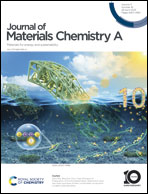Crystal graph convolution neural networks for fast and accurate prediction of adsorption ability of Nb2CTx towards Pb(ii) and Cd(ii) ions†
Abstract
Precisely measuring the adsorption capability of materials towards toxic heavy metal ions in aqueous solution is essential for the synthesis of effective novel adsorbents. Nonetheless, no such technology is available that can accurately measure the adsorption capability at arbitrary adsorption sites. In the present study, we employed an artificial intelligence route to predict the adsorption capability of two-dimensional niobium carbide (Nb2CTx) at arbitrary adsorption sites for lead (Pb(II)) and cadmium (Cd(II)) ions. A crystal graph convolution neural network (CGCNN) model was applied to predict the adsorption capability of Nb2CTx with the results indicating that Pb(II) ions had a higher adsorption energy than Cd(II) ions with a mean absolute error and root-mean-squared error less than 0.09 eV and 0.16 eV, respectively. The proposed CGCNN model has a similar prediction to the ab initio DFT calculations, yet significantly fast and economical. Finally, the adsorption capability of Nb2CTx synthesized using a fluorine-free route was also experimentally verified, and the results were consistent with DFT calculations and CGCNN predictions. In addition, the synthesized Nb2CTx exhibited a higher recycling potential over five successive runs. Collectively, these findings indicated that the proposed technique is highly efficient in investigating the adsorption performance of materials and can be further extended for use in the removal of other hazardous pollutants from aqueous environments.

- This article is part of the themed collection: #MyFirstJMCA


 Please wait while we load your content...
Please wait while we load your content...